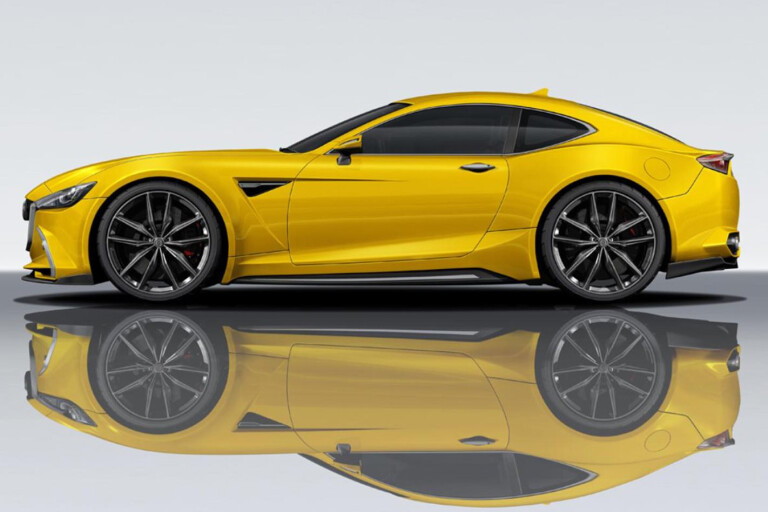
A Japanese magazine famous for wild predictions of variable accuracy says Mazda’s board of management has already signed off on its next rotary-engined sports car, determining that it will go on sale in 2020 wearing an “RX-9” badge on its shapely butt and be priced around the 8 million Yen mark (AU$104,000 at current exchange rates).
The report, published by Holiday Auto magazine and accompanied by some enticing renderings of a fat-fendered yellow coupe, also states that a 1.6-litre turbo rotary will feature under the bonnet, with roughly 300kW powering a rear-driven two-seater body weighing under 1300kg. Our first experience of it should be at next year’s Tokyo Motor Show in October according to Holiday Auto, where it will be previewed in concept form.
But how correct is the report?
 Many point to Mazda’s recent patent application for the name “RX-9” as a signal that the brand’s high-performance halo car will wear that badge, but we don’t reckon that’s likely. Why? Mainly because it doesn’t fit in with Mazda’s long-established naming conventions.
Many point to Mazda’s recent patent application for the name “RX-9” as a signal that the brand’s high-performance halo car will wear that badge, but we don’t reckon that’s likely. Why? Mainly because it doesn’t fit in with Mazda’s long-established naming conventions.
As a two-door, two-seat rotary powered coupe, there’s only one badge that’s appropriate – RX-7.
There were three generations of Mazda RX-7 over nearly three decades and they all bore the same basic configuration. When the Japanese automaker followed up the third-gen RX-7 with the RX-8, the name change was in line with the car’s increased size and its four-door, four-seat layout.
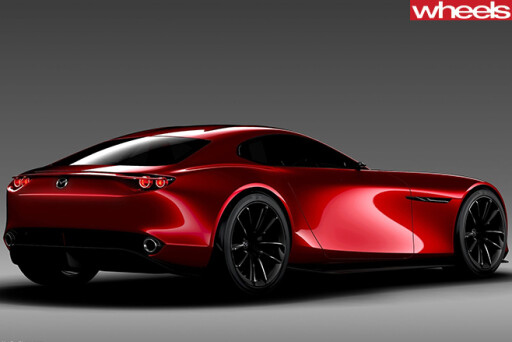 Rather, the trademarking of RX-9 is likely part of a hedging strategy designed to give Mazda’s marketing people an element of choice when time comes to figure out the car’s name. After all, the last time Mazda applied for a trademark on “RX-9” was in 2001, back when the company was finalising development of what was eventually named the RX-8. One other option on the table back then was “RX-10”, though Mazda has elected not to renew its ownership of that name this time around.
Rather, the trademarking of RX-9 is likely part of a hedging strategy designed to give Mazda’s marketing people an element of choice when time comes to figure out the car’s name. After all, the last time Mazda applied for a trademark on “RX-9” was in 2001, back when the company was finalising development of what was eventually named the RX-8. One other option on the table back then was “RX-10”, though Mazda has elected not to renew its ownership of that name this time around.
History also works against it: in the late 1970s Mazda sold a rotary-engined version of the 929 sedan in Greece and other markets as the RX-9. Transplanting the badge of a long-dead executive barge onto a sleek coupe seems a little bit off.
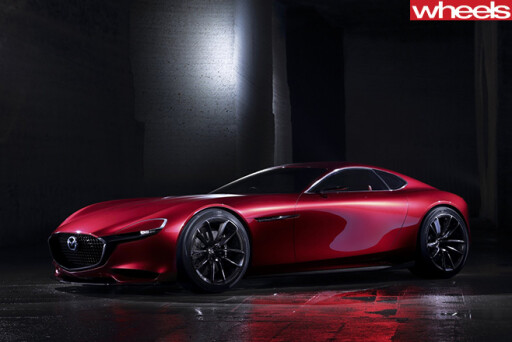 And would Mazda give up the opportunity to capitalise on the fond memories many enthusiasts have of previous RX-7s? It’s tremendously unlikely, and that’s probably why Mazda continues to retain a trademark on the RX-7 badge.
And would Mazda give up the opportunity to capitalise on the fond memories many enthusiasts have of previous RX-7s? It’s tremendously unlikely, and that’s probably why Mazda continues to retain a trademark on the RX-7 badge.
The 2020 launch timing (following a debut at the 2019 Tokyo Motor Show) also seems too far in the future. Previous rumours say the production car will show its face at the 2017 Tokyo Motor Show next October, which would be fitting considering 2017 marks 50 years since Mazda launched its first rotary-engined car, the Cosmo.
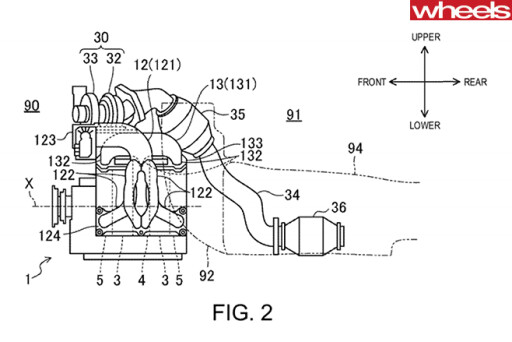 There’s always the chance Mazda may, like many other Japanese automakers, elect to take its time and release a less flamboyant concept to plug the gap between last year’s gorgeous RX-Vision showcar (pictured) and the next-gen RX-7, but Mazda would be well advised to strike while the iron (and the internet hype mill) is still hot.
There’s always the chance Mazda may, like many other Japanese automakers, elect to take its time and release a less flamboyant concept to plug the gap between last year’s gorgeous RX-Vision showcar (pictured) and the next-gen RX-7, but Mazda would be well advised to strike while the iron (and the internet hype mill) is still hot.
The 300kW power output in Holiday Auto’s report is speculative, but from what we already know of the next RX-7’s rotary engine it’s not out of the realm of possibility. Mazda has been honing a 1.6-litre successor to its venerable 1.3-litre two-rotor motor for over eight years now, and recent patent applications indicate that it’s on the verge of being production-ready.
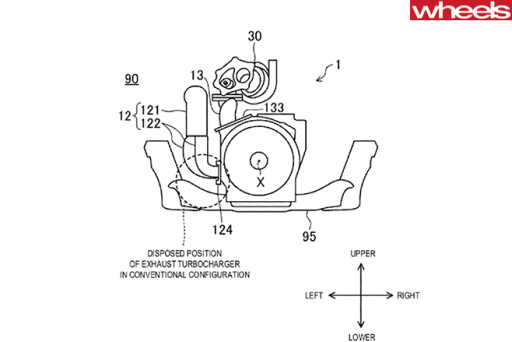 Images filed in Mazda’s patent for its latest rotary engine confirm the presence of a turbocharger, which now sits right on top of the engine – imagine the wow factor when you open the bonnet to show off to your mates.
Images filed in Mazda’s patent for its latest rotary engine confirm the presence of a turbocharger, which now sits right on top of the engine – imagine the wow factor when you open the bonnet to show off to your mates.
Exhaust and inlet ports have also done a switcheroo, with burnt gases now exiting at the top of the engine (and straight into the turbine housing for optimal response) and fresh air entering at the bottom (for longer intake runners to promote low-end torque).
In our recent interview with Mazda engineering maestro Dave Coleman (check it out in the August issue of Wheels, page 23), we learned Mazda’s next rotary will preference torque over revs, losing some of the high-rpm thrills that characterise rotaries but gaining some much-needed driveability and fuel economy as a result.
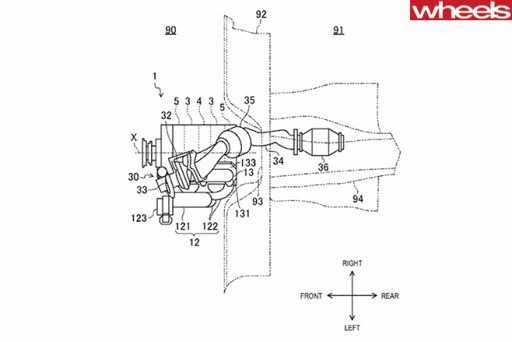 Mazda’s patent application for its new engine – expected to be marketed as the SkyActiv-R – also describes the engine’s position as being nestled against the firewall, allowing a 50:50 weight distribution.
Mazda’s patent application for its new engine – expected to be marketed as the SkyActiv-R – also describes the engine’s position as being nestled against the firewall, allowing a 50:50 weight distribution.
Emissions won’t be neglected either, with the new engine illustrated with two cantaloupe-sized catalytic converters behind the turbo to help scrub pollutants from its exhaust gas. Rotary engines haven’t been known for their environmental friendliness, but Mazda is determined to make its piston-less engine play nice with Mother Nature.
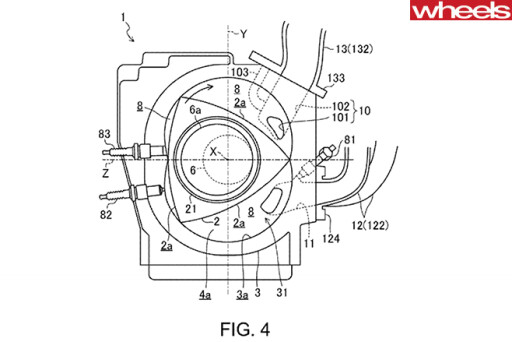 As for its weight, word on the street is that Mazda will engineer a slightly bigger version of the Mazda MX-5’s rear-drive platform for the new RX-7. With the MX-5 weighing just over a tonne with no roof and a four-cylinder engine, a 1300kg kerb weight for the RX-7 is certainly realistic.
As for its weight, word on the street is that Mazda will engineer a slightly bigger version of the Mazda MX-5’s rear-drive platform for the new RX-7. With the MX-5 weighing just over a tonne with no roof and a four-cylinder engine, a 1300kg kerb weight for the RX-7 is certainly realistic.
Long story short: a new rotary Mazda is coming, but it’ll most likely see the triumphant return of the RX-7 badge and it could be ready in time for next Christmas. It will be light, it will have torque, it will have a turbo and it will probably thrill the pants off you. We can’t wait.

COMMENTS